|
TRANSLATE THIS ARTICLE
Integral World: Exploring Theories of Everything
An independent forum for a critical discussion of the integral philosophy of Ken Wilber
 Mark Edwards has an M.Psych in Developmental Psychology and a PhD in organisation theory from the University of Western Australia. He now works at Jönköping University in Sweden where he teaches and researches in the area of sustainability and ethics. Before becoming an academic he worked with people with disabilities for twenty years. He is the author of Organizational Transformation for Sustainability: An Integral Metatheory (Routledge, 2009)
.
Part I | Part II | Part III | Part IV | Part V | Part VI | Part VII
Through AQAL Eyes
Part 4:
A New Theory of Holons
By Mark Edwards
Introduction
Judging from the excerpts currently being posted on the Shambhala site, Volume II of Ken Wilber's Kosmos trilogy is going to be a major point in the evolution of his Integral philosophy. In working through the basic philosophical premises of his Integral philosophy, Wilber is now bringing together much of his previous writing and, amazing as it may seem, he is integrating even more fields of enquiry and human knowledge quests than previously. One intriguing aspect of Wilber's latest writing is the very central role played by the holon construct. It's becoming more and more evident that the holon construct lies absolutely at the heart of Integral philosophy. For that reason it's important that Ken gets his holon principles right and that he applies them in a consistent and valid way. In Excerpts C and G of volume 2 of the Kosmos Trilogy there's plenty of evidence that tells me this ain't happening.
As I pointed out in the third of my series of essays on holon theory, the holon construct is the pivotal link that allows Integral philosophy to integrate all previous attempts at describing reality. It can do this because the holon provides a referential unit of analysis that is not tied into any single scientific field, philosophy, cultural viewpoint, or aspect of being (ontological structure). Amazingly, the holon construct allows us to take a third-person view of our realities without reducing it to some impoverished shadow of itself. Consequently, the Integral view is not reliant in its explanations of complexity on the measurement of space/time, or matter, or atoms, or thoughts, or genes, or neurological networks, or minds, or social events, or religious dogmas, or mystical experiences, or selves, or objects. To put it simply, a holon is a integrative perspective and, as Wilber now puts it, reality is constituted by perspectives. It's essentially Wilber's use of the holon construct (in the context of the AQAL system) which helps him to describe the theoretical aspects of his philosophy so logically and elegantly.
This is why it is so crucial that holon theory be placed on a firm foundation right from the start. However, at this point in time, it is very clear to me that that firm foundation has not yet been built. While the basics of the holon construct seem to be straightforward enough, it's clear to me that there are serious misunderstandings and inconsistencies in the way elemental aspects of holon theory are applied and interpreted. To this point I still don't think that Ken Wilber has actually provided a coherent description of the holon itself or how it fits into his AQAL structure. To give but one example, there is the whole confusing issue of how holons can occupy separate quadrants. I also believe that Wilber is confounding some dimensions of holonic reality with others. In the following, I want to draw attention to such confusions and show how they are still confounding important issues that Wilber is currently writing about.
Those small number of you who have read any of my essays on Integral theory will know that I am an enthusiast supporter of Wilber's vision. All my criticisms of his ideas are intended to be constructive and come out of a desire to further Integral theory as a coherent system of ideas. The following comments on Wilber's representations and uses of holons are no different. I put forward these criticisms with full awareness that they are based on a framework that Wilber himself has developed. As such, all of these comments are intended to come out of an Integral perspective. How can I be critical of Wilber from a perspective based on his own work? Well, quite simply, I believe that Wilber has not applied the basic principles of his model across all aspects of his writings. This is mainly due to the fact that there has been ongoing development in his ideas (we're up to phase 5 it seems now) and some of his earlier propositions have not been updated to accommodate the expanded vision of his later work. With regard to holon theory, Wilber introduced Koestler's holon model from the early 1980's and, although his use of the concept has been become immensely important for the model, I still believe that holon theory has not been fully integrated into the later aspect of Wilber writings such as the AQAL framework and his current work on social membership, and cultural inclusion.
My modest aim here is to point to some aspects in Wilber's latest writings that we need to question and debate more fully. I know that Wilber has many critics who are not very familiar with the subtlety of his ideas and I am not impressed with much of the outside criticism that Wilber has received. What concerns me more at the present moment is that serious students and readers, who are supportive of the Integral approach, are accepting many of Wilber's propositions without question and I, for one, don't think that this is a good thing. There are several aspects of Wilber's interpretation of the basic Integral framework that have been around for many years and which, in my opinion, are still very questionable on the basis of Integral theory principles that he himself has proposed. Wilber would be the first to say that Integral theory, like all other knowledge quests, is a work in progress and subject to the interpretations of its authors and practitioners. Ken has mapped out the basic model and is giving us his interpretation of its details. To be sure, they are the interpretations of the master pundit but they are interpretations of the model nonetheless.
In my opinion Wilber has created a vast system of thought some of whose parts do not always coherently co-exist in their present form even at a very fundamental level. In the past I have offered suggestions for bringing more consistency to the model through merging the epistemological wing of the model with its developmental wing (see my “Integral Cycle” essay) and through integrating holon theory more fully into the AQAL framework (the “Through AQAL Eyes” series). I want to continue with this investigation of inconsistencies in Wilber's explication of Integral philosophy while working from within the basic principles of Integral theory. In the following, I point to some weaknesses in his interpretations and suggest some alternative ways of applying the holon model that might make the whole wonderful thing just that little bit more internally consistent and externally valid.
How to be confused about holons without really knowing it
I have said this before and I'll say it again - quadrants do not contain holons. I have gone into some detail on the confusion over the relationship between holons and quadrants in “Through AQAL Eyes: Part 2”. To put it bluntly, it is a fundamental premise of Wilber's Integral philosophy that holons do not occupy quadrants and yet he regularly ignores this principle. Quadrants are first and foremost perspectives that are shared by all holons. Holons are not objects or processes which move around quadratic landscapes. The reason for this is that once we see holons as occupying quadrants we encounter Cartesian dualism in all its full glory. If we think of holons as existing within quadrants, our previously non-reductive holons are reduced to either sentient or insentient holons, or agentic or communal holons. And this sets us off on the whole non-integral path of separating sentient entities from insentient entities. The Integral perspective is that all holons are at the same time a subject and an object and have agency (self-preservation) and communality (self-adaptation) (This is why the very problematic Wilber-Kofman model of holonic categories has such unfortunate implications for the application of the AQAL model [see Through AQAL Eyes: Part 1]).
Wilber clearly states that quadrants do not contain holons as the following quote attests,
“The four quadrants are not four different occasions but four different perspectives on (and hence dimensions of) every occasion” (Excerpt C, ¶ 11 – to be read as paragraph 11 of Excerpt C).
And again,
“Of course, there are not different holons in the four quadrants; the four quadrants are the four dimensions of every holon” (Excerpt C, ¶ 57).
But such very firm statements on the quadratic nature of all holons are often followed by statements to the opposite effect,
“But it is easier and simpler to say things like 'holons in the UR quadrant,' and so on, which is fine, as long as the tetra-nature of any holon is remembered” (Excerpt C, ¶ 57).
I actually doubt that it is ever “fine” to represent holons as occupying quadrants because doing so immediately opens up every conceivable dualistic trap that Integral theory is trying to avoid. Wilber has already fallen into one of these traps with his proposition of the profoundly dualistic notion of sentient and insentient categories of holons. For the past twenty years Wilber's writings have shown this inconsistency between presenting holons as entities within quadrants while stating that the theory actually prescribes the opposite. The text of Excerpt C is full of references and diagrams which unfortunately place holons in quadrants. This is clearly evident in Figures 2 & 3 in Excerpt C and in the following quotations from the text.
In this Excerpt, we will take as examples actual occasions (or holons) in each of the four quadrants (Excerpt C, ¶ 5)
That is, the holons in all four quadrants have insides and outsides. As you can see in figure 2, there is the inside and outside of an "I"-holon, a "we"-holon, an "it"-holon, and an "its"-holon. (Excerpt C, ¶ 74)
For this discussion, an "individual" means any holon in the upper quadrants ... and a collective, group, society, or system means any holon in the lower quadrants (Excerpt C, ¶ 204)
With that in mind, we can use the word interior to refer to any occasions or holons in the Left-Hand quadrants, and exterior for any occasions in the Right-Hand quadrants. The upper quadrants refer to individual or singular holons, and the lower quadrants refer to plural, social, or communal holons. So the four quadrants represent the interiors and the exteriors of the singular and plural (Excerpt C, ¶ 58)
Exterior, on the other hand, means any phenomena apprehended in a third-person perspective (i.e., any phenomena or holon in the Right-Hand quadrants (Excerpt C, ¶ 64)
The problem here is that this is not just a semantic quibble. Some of Wilber's key interpretations of Integral principles are influenced by this inconsistency. For example, if holons do not occupy quadrants how can there be collective holons in the lower quadrants while individual holons occupy the upper quadrants? The whole way in which we understand the quadrants themselves is determined by this issue. Much of Wilber's discussion on the concept of a “cultural nexus” and the “we/thou” space depends on multiple holons being portrayed as cohabitating a single quadrant. His detailed elaborations (wonderful as they are) on the relationship between the “I” and the “We” is often based on his separating social holons in the lower quadrants and individual ones in the upper quadrants. I'll return to these issues in a later essay. For now I only want to point out that this matter has to be clarified. Holons never occupy quadrants. If we think of them as doing so then there are serious questions as to whether our analysis of a situation is truly integral. And it is likely that both weak reductionism and some element of, what Wilber refers to as, the second Cartesian dualism will be involved.
It is not logically consistent to define holons as the mutual arising of the four quadrant perspectives only then to represent them as existing within one or two quadrants. The human holon of, for example, a child has consciousness, behaviour, cultural being and social presence because it has the four basic perspective of each and every holon. What on earth does it mean then to place this human holon within one of the quadrants? I am sure that there could be some very interesting discussion here of fractals or infinite regressive series or something but in terms of Integral theory as a consistent and parsimonious theory such inconsistencies mean that the model becomes self-contradictory. It is axiomatic that holons are quadratic perspectives and this means that they cannot be considered in terms of only one or two quadrants without falling foul of reductive pitfalls. When holons are situated within quadrants the dangers of weak reductionism become apparent. If we place human holons in interior quadrants then we can easily begin to think that perhaps exterior behaviour is not so definitive of human identity as interiority. If we situate individual human holons in the upper quadrants then we are more likely to assume that they are individual entities more than they are social entities. If we place social holons in the lower quadrants we see them as not having any particular type of agency, or consciousness or behaviour that is purely social (rather than the outcome of an aggregate individual agency).
Ever since his first really detailed treatment of holon theory in “Sex, Ecology and Spirituality” Wilber has consistently referred to holons as existing within certain quadrants. His examples and logical arguments are full of descriptions which represent holons as occupying particular quadrant domains. It may be disingenuous to accuse probably the most non-reductive thinker in history of being reductive, but is it very likely that some reductive errors confound the propositions that he is putting forward because of the inconsistent manner in which he presents holonic theory. Even in his latest writings this tendency is evident. In the following example I want to show how the representation of holons impacts on just the aspect of clarity of the model. I will deal more fully with more important matters in a later section (and in the following essay).
Wilber's Zones
The following is one example where we can greatly improve on one of Wilber's ideas by replacing his dualistic approach, that separate holons exist in separate quadrants, with the basic Integral principle, that quadrants simultaneously arise in each quadrant. Wilber's wonderful concept of holonic zones (“hori-zones”) are simply divisions of the holon that arise when the focus is on perspectives rather than developmental structures. The four zones he describes in Excerpt C are opened up when the interior-exterior dimension (i.e. consciousness–behaviour) is crossed with an inside–outside dimension. Hence zone #1 is the inside-interior, zone #2 is the outside-interior, zone #3 is the inside exterior and zone #4 is the outside-exterior. Unfortunately Wilber illustrates these division by putting a holon in each quadrant to show its inside and outside aspects.
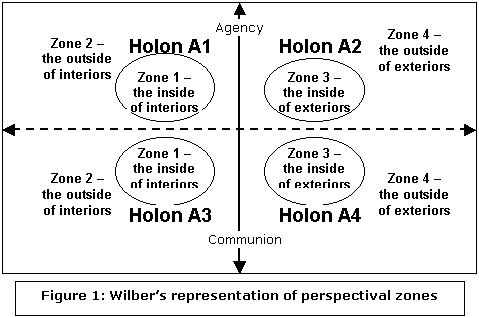
Apart from the fact that it separates one holon into four, Wilber's presentation of zones shown in Figure 1 immediately conveys the impression that the four interior zones of a holon are all somehow distinct from each other in quadratic space. To represent a single holon in this way is clearly confusing and runs counter to the general intent of what Wilber is trying to convey. To give but one example of how misleading this representation is, take the issue of language and consciousness. Some form of language is essential for the development of personal consciousness. We use speech, both internal and public speech, to define who we are, to regulate our behaviour, to work out what we actually think, and to maintain a coherent self sense. At the same time language is always inherently communal and relational. This means that our consciousness is also inherently communal. One's personal identity and one's cultural identity are obviously intimately entwined in each other. I am not saying that they are the same thing, but that if we represent the agentic interior of a holon as separate from its communal interior then we will immediately set off on the wrong foot in the journey to find out how they relate to each other.
In contrast to Wilber's representation, a better way of showing the relationship between the inside and outside of a holon's interior-exterior dimension is to simply present it the way that Integral theory has always formally conceived holonic identity (Figure 2). This way you don't need to use four holons in separate quadrants and the whole concept of perspectival zones becomes much clearer and, dare I say it, more integrated.
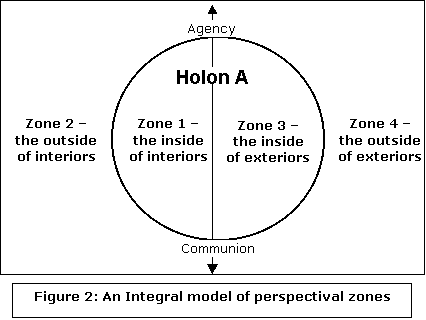
This can be put very simply: What is the best way to represent the Integral nature of interior identity? i) By representing them as distinctly different holons that occupy separate quadrants (figure 1), or ii) to say that they are two perspectives on the same holon (figure 2). Clearly the latter is more preferable and Wilber would obviously agree. The question remains however, why doesn't he adopt this approach consistently in all his writings and diagrams.
Notice that in figure 2, in contrast to Wilber's approach, there is no division between the holon's agentic consciousness and its communal consciousness. There is no separation between an indidivual holon's “I” and it's “We”. They simply arise together as soon as any holonic boundary is drawn. Every single human holon has an “I” and a “We” from the day it comes into being (whenever you might want to define that). Our genes, our emotions, our language, our worldviews our values are all intimately and simultaneously definitive of both my “I” (my agentic self) and my “We” (my cultural self). In holonic terms my agentic consciousness is not separate from my communal consciousness (and, I would add, nor is my behavioural identity separate from my social identity – they all arise together). Because Wilber artificially places separate holons into different quadrants his path from “I” to “We” is a much more circuitous one. I'll set this out more fully in a following section.
I have shown in this example of Wilber's zones of perspectives that it is simpler and more consistent with the whole intent of Integral theory to depict a holon as an integrated AQAL matrix rather than as independent objectives entities floating above a reified AQAL background. The latter method of presentation, which Wilber often uses, not only unnecessarily confuses any discussion but also leads to some important errors in applying the AQAL framework itself. I will show how some of Wilber's work is prone to these problems in the following paper, but first why don't we immerse ourselves in one great big semantic mess.
The Individual-Collective, Agentic-Communal, and Singular-Plural Mess
Another aspect of holon terminology where there continues to be great confusion is in the actual meaning of the terms that define the quadrants. The use of terminology for the interior-exterior dimension is not so much a problem (although I can see that the new holonic dimension of inside-outside could cause some difficulties down the line). But there are real problems in the use of the term “individual-collective” to describe what is better called the agentic-communal dimension (agentic-relational would probably be even better). The reason for these problems is that Wilber (and almost everyone else) also uses these terms to describe completely different types of holons, i.e. individual holons such as a person, and collective holons such as a village. So we have this impossible situation of confusing quadrants with types of holons.
This mess has to be cleaned up as soon as possible. One of the disastrous outcomes of this confusion has been the continued and frequent presentation of a holon where the upper quadrants represent “individual holons” and the bottom quadrants represent “collective holons”. This type of “mixing” problem currently plagues the whole discussion of holon theory. Wilber is the worst offender in this regard. Here are some examples of how he mixes holons and quadrants from his latest offering.
The upper quadrants refer to individual or singular holons, and the lower quadrants refer to plural, social, or communal holons. So the four quadrants represent the interiors and the exteriors of the singular and plural. (Excerpt C, ¶ 58) (emphasis in the original)
The upper quadrants represent an individual being; the lower quadrants represent a group, collective, or system of individual beings. (Excerpt G, ¶ 43) (emphasis in the original)
Here we have Wilber mixing holons, mixing quadrants, mixing the terms individual and singular and mixing the terms plural, social and communal in a quagmire of confusion. With regard to his very quaint example of a flock of geese he says,
Quadratically, then, we have the following ... in the UR, we find the behavior of each individual goose ... The social system [the LR] ... is the network of behavioral interactions between the geese ... In the UL, each goose has [a] ... sentient registration of his or her interior ... When two or more geese are together, they resonate with each other, ... this set of mutual prehensions is ...the cultural "we" ... ( LL). (Excerpt C, ¶ 407)
In this geese example Wilber clearly thinks that the single collective holon of the flock of geese has individual geese in the top quadrants and multiple geese in the bottom. This is complete nonsense. Integral theory looks at the flying V formation of geese and says that the flock is a single collective holon. And that this one holon of the flock has a type of group consciousness (UL), has a particular set of behaviours (UR), has a particular culture of goosinessness (LL), and has a social structure relative to its physical and ecosystem environments (LR). But these are ALL aspects of ONE holon. There are not separate geese holons in separate quadrants and there are certainly not multiple geese in the communal quadrants (remember that holons don't occupy quadrants). If we want to look at individual geese then the holon in question is an individual holon and not a mixture of single geese and multiple geese in various quadrants (quadratic geese!!! please excuse me while a laugh quietly to myself for a few minutes). The following quote shows just how mixed up Wilber is over this matter.
For this discussion, an "individual" means any holon in the upper quadrants ... and a collective, group, society, or system means any holon in the lower quadrants (Excerpt C, ¶ 204)
In graphic form Wilber's mixing of holons and quadrants can be represented in a number of ways. All of them are highly problematic to say the least. The following are three possible interpretations of how Wilber intends us to see how holons and quadrants relate to each other. The first misrepresentation has one holon in the upper quadrants and a number of individual holons in the lower quadrants that together make up a collective holon.
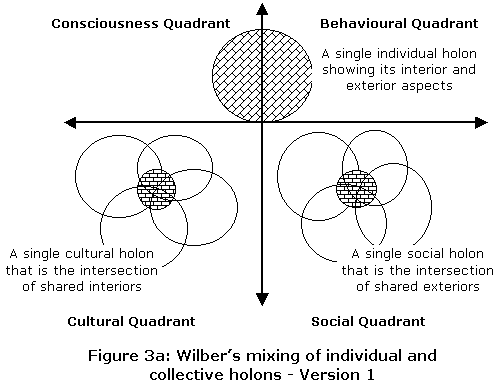
The second version has a number of holons in each quadrant with each of the upper ones being individual holons and each of the lower ones being collective holons.
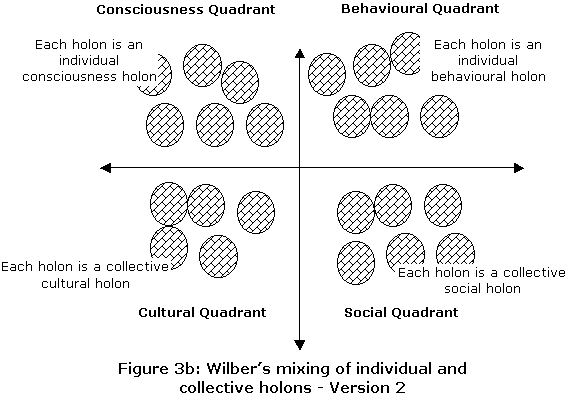
Each of these versions represent either diagramatic or verbal descriptions of the way that Wilber sees the relationship between holons and the AQAL model. The confusion over how these two central aspects of Integral theory relate to each other is clearly apparent. This is why I have attempted to integrate the two in a much more intimate way than has previously been considered (see “Through AQAL Eyes Part 2”). In fact I have proposed that the holon and the AQAL framework are describing exactly the same theoretical propositions. So the preservation-adaptation dimension of a holon is precisely the same thing as the agency-communal dimension of AQAL, the subject-object dimension of the holon is exactly the same thing as the interior-exterior dimension of the AQAL model, and the transcendence-immanence drives of holons are precisely the same thing as the Ascending-Descending, Eros-Agape drives of the AQAL model (see table 2 in “Through AQAL Eyes Part 2” for a complete matching up of holonic tenets and AQAL principles).
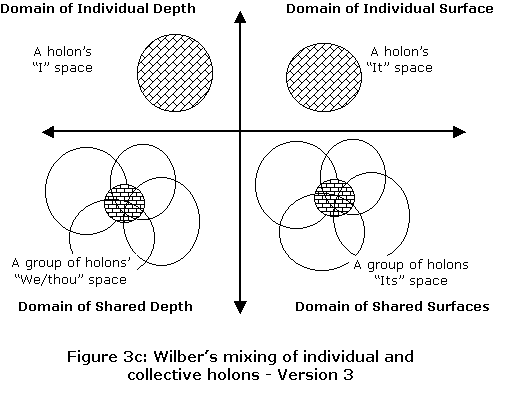
The third version of Wilber concept of holons is his labelling of the quadrants as subjective or "I," objective or "it," intersubjective or "we," and interobjective or "its". This model makes it very clear that Wilber sees single holons occupying the upper quadrants and plural holons occupying the lower from both inside and outside perspectives. This version also reveals Wilber's idea that true developmental depth relates to the left quadrants and that the right only reflects that depth through surface correlations, if at all. Hence the left hand is the world of the feeling, thinking subject(s) and the right hand is the world of material it(s). Once again, I believe that this is a very reductive view of how the holon should be used to represent AQAL perspectives. (I'll also offer an alternative version of what Wilber refers to as the “indigenous perspectives” of a holon in a later section.)
When Wilber plugs separate holons all over the AQAL quadrants he runs the risk of reinforcing the reductionist idea that, for example, thoughts are separate from behaviours which are separate from values which are separate from social actions. Integral theory fundamentally says that they are not. From an Integral view thoughts, behaviours, values and social acts are ALL aspects of a single holon. This means that behaviours and social interactions develop together with feelings, thoughts, cultural interpretations and worldviews. As Wilber says, “they all arise together as perspective-occasions of the self-reflexive Kosmos”. When we represent this appearing togetherness in Integral terms we do it by showing a single holon as an AQAL matrix, and not as separate “building block” holons set against a reified AQAL backdrop. Figure 4 shows the Integral view of holonic and AQAL relations. The examples provided in Figure 4 are for an individual holon but the diagram as a whole applies just as much to any holon, individual, collective, or otherwise).
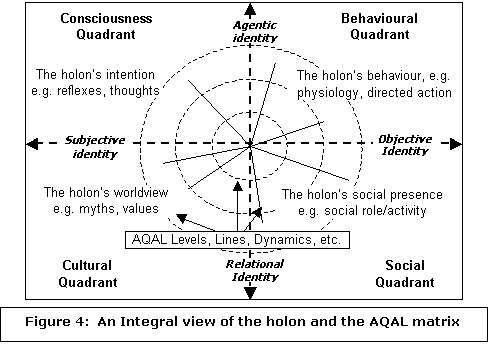
The mixing of individual and collective holons and dimensional terms has some unfortunate implications for the way that Wilber works through such issues as holonic membership, collective agency, and the relationship between individual and collective holons. I will raise some of these issues in a later essay. First, I want to visit this issue of defining individual and collective holons. Then I have some suggestions for cleaning up all these semantic and representational confusions.
Defining Collective and individual
The issue of defining individual holons as something different to collective holons is a difficult one. Wilber has noted the definitional problems saying that, “where to draw the line between individual holon and collective holon is a slippery endeavor”. But I believe the solution is really quite straightforward once the weeds of confusion in terminology have been separated out. I am not wanting to be overly prescriptive in offering these suggestions and “Lord knows” I don't want to have the evil tag of thought police attached to any of this. But the mess runs so deep in holonic jargon that something has to be done. The following is my way out of the morass.
First by “individual” I do not mean “single” or “one of”. And by “collective” I do not mean “group” or “aggregate”. For example, it is surely not advisable in this definitional minefield to talk of such things as an “individual collective holon” when referring to a “single collective holon” or a collective of individuals when one means a group. Second by “individual” I do not mean “agency” or any quality that can be used to define one pole of the agency-communion dimension of a holon. Similarly the term “collective” should not be used to refer to the communal or relational pole. This means that the term “individual-collective” should NEVER be used to refer to the “agency-communal” dimension of a holon or AQAL matrix. Third, I think it is best not to refer to a person in such discussions as an individual but rather as a human being or a human holon, or whatever. For example, we can have an individual holon that is, in fact, not a person but an atom, or a planet, or whatever. With all these uses of the term “individual” set apart I propose that the terms “individual holon” or “collective holon” be used to refer specifically to holons that form part of a holarchy made up of individual holon or collective holons respectively. I know, I know, It's OK, hang on, just give this a bit of time. Let's say we have some particular holarchies. These holarchic series can be represented in a linear sequence form (holarchy 1), in a nested graphic form (holarchy 2), or in tabular form (holarchy 3).
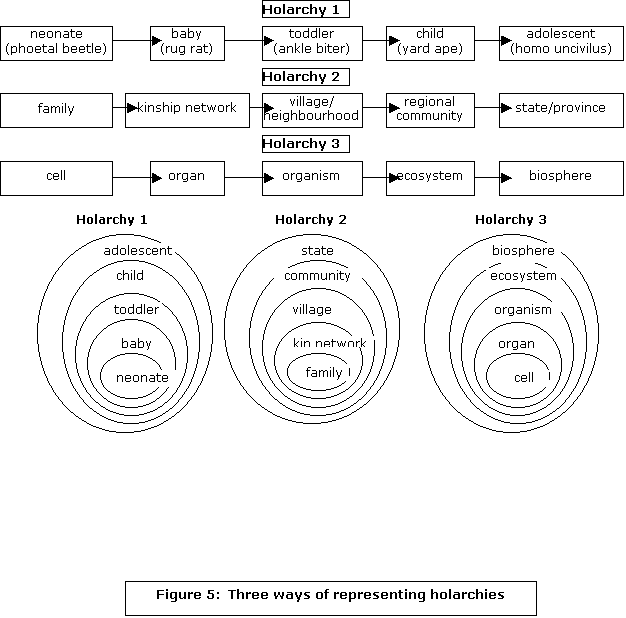
Holarchy 1 is made up of individual holons, holarchy 2 is made up of collective holons and holarchy 3 is an unfortunate mixture of both. The point here is that any item from holarchy 1 is by definition an individual holon. Any item from series two is by definition a collective holon. Any item from holarchy 3 could be either and therefore the holarchy is invalid and needs to be verified using the set of holonic laws or tenets (see “Through AQAL Eyes Part 2”).
This example is an attempt to clarify how I believe holons should be defined, i.e. in terms of their parental holarchies. Hence, individual holons can be defined as holons that are nodes in a parental holarchy of individuality. Collective holons can be defined as nodes in a parental holarchy of collectives. Consequently, it is the holarchy that defines what type of holon we are dealing. Using examples from the holarchies above, possible Integral representations of the individual holon of the “toddler” and the collective holon of the “village/neighbourhood” are presented in Figure 6 (a & b).
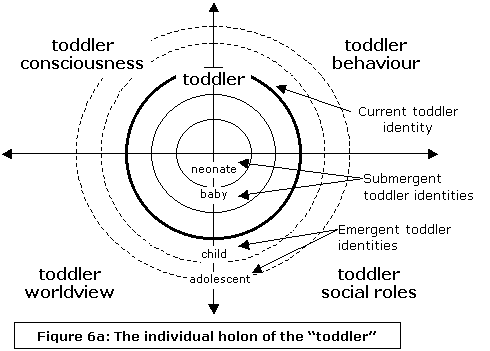
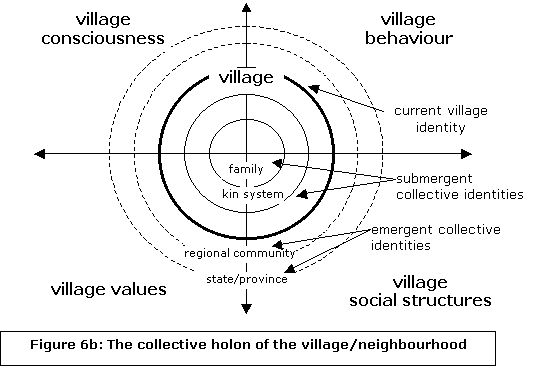
Figure 6a makes it very clear that a toddler is an individual human holon because it comes out of such a holarchy. Figure 6b makes it clear that a village is a collective holon because it comes from a holarchy of human collectives. In this way the definition and analysis of holons is treated in a consistent and logical manner and we don't mix up individual and collective holons in the same diagram or analysis as Wilber regularly does. They both have quadrants, levels, lines, and all the other Integral dynamics (such as evolution-involution that the AQAL model includes (but which Wilber never mentions in the context of the AQAL acronym). This approach of defining holons in terms of their parental holarchies shifts the whole burden of definition back where it belongs – onto the defining set of holonic tenets and AQAL principles. This is vital because it ensures that valid holarchies are always seen as the context of holons and provides a means for verifying that their part-whole relationships with other holons in the holarchic series are valid, as seen in holarchy 3 of figure 5 (this in turn completely removes any need for the Wilber-Kofman model holonic categories to ensure that holarchies are not “mixed” – see Through AQAL Eyes part 1). This approach provides a much more consistent and clearer representation of holons and how they are to be methodologically included in the AQAL metatheory.
Having described an Integral approach to how holons can be consistently and clearly defined and represented I will make some general suggestions along these lines.
Suggestions for clarifying the representation and description of holons and the AQAL matrix
- Suggestion 1: Whatever the form (verbal, graphic, or tabular form), holons should always be represented in terms of the simultaneous and unified arising of the AQAL matrix (as in Figure 4 above) with all its key accompanying structures and dynamics.
- Suggestion 2: Whatever the form (verbal, graphic, or tabular form), holons should never be represented in terms of separate holons occupying separate quadrants of the AQAL matrix (as in Figure 3 above).
- Suggestion 3: Always represent individual and collective holons as each having their own complete set of AQAL characteristics (as in figure 6).
- Suggestion 4: Never mix individuals and collective in the one holon by placing individuals in the upper quadrants and collectives in the lower quadrants (as in figure 3).
- Suggestion 5: Always use the terms “agency” and “communion”, or “self-preservation” and
“self-adaptation” to describe that dimension of holons
which which distinguishes between the upper and lower quadrants.
- Suggestion 6: Never use the terms “individual” - “collective” or “singular” - “plural” or "one"
-"many" to describe that dimension of holons which distinguishes between
the upper and lower quadrants.
- Suggestion 7: Always label holons (e.g. individual holons or collective holons) in terms of their prental holarchies.
- Suggestion 8: Use the term “individual holon” to refer to holons that come from a parental holarchy which describes the ontogenetic development.
- Suggestion 9: Use the term “collective holon” to refer to holons that come from a parental holarchy which describes phylogenetic development.
- Suggestion 10: Always ensure that a quadrants diagram represents either a single holon or a single holarchy.
- Suggestion 11: Always remember that each holon, whether it be an individual or a collective holon, will have agency and communion and interiority and exteriority.
I am sure that there might be better ways of dealing with some of the confusions that abound in the definition and application of holons and holonic theory. Some of you might have some suggestions for improving what I have offered here. The real problem with all this is that the great majority of Integral theory practitioners don't really understand why such issues are important in the first place. But as I have said, the holon lies at the heart of the whole Integral theory edifice, as is apparent from Wilber's current writings. If the foundations ain't precise the upper storey elaborations might not be completely sound. In the next part of my series on holons I will to explore some areas in Wilber's writings where weaknesses are present exactly because of the imprecise use of the holon construct.
Conclusion
In the foregoing I have opened up a few areas of discussion on Wilber's approach to representing holons and quadrants. I believe that there are several important weaknesses in these representation. More importantly I also think that these weaknesses have very significant implications for the way Wilber applies holonic theory to issues such as personal behaviour, social membership and relational exchange. Ken seems at the moment to be set in his present course of mixing up quadrants and holons, personal and social holons, and confusing individual and collective holarchies with agentic and relational drives. To be honest I don't see much chance of him reforming his ways. This is unfortunate because as a result of these confusions some of his current writings bear unmistakeable signs of dualistic interpretations of Integral theory and reductionist applications of its core principles. His propositions of separate holonic categories, his definition of social membership, his understanding of the behavioural quadrant, and his discussion of relational exchange all show clear evidence of these tendencies. In the next part of my series on holons I will to explore some areas in Wilber's writings where weaknesses are present exactly because of the imprecise use of the holon construct.
© Mark Edwards
|
 Mark Edwards has an M.Psych in Developmental Psychology and a PhD in organisation theory from the University of Western Australia. He now works at Jönköping University in Sweden where he teaches and researches in the area of sustainability and ethics. Before becoming an academic he worked with people with disabilities for twenty years. He is the author of Organizational Transformation for Sustainability: An Integral Metatheory (Routledge, 2009)
.
Mark Edwards has an M.Psych in Developmental Psychology and a PhD in organisation theory from the University of Western Australia. He now works at Jönköping University in Sweden where he teaches and researches in the area of sustainability and ethics. Before becoming an academic he worked with people with disabilities for twenty years. He is the author of Organizational Transformation for Sustainability: An Integral Metatheory (Routledge, 2009)
.








